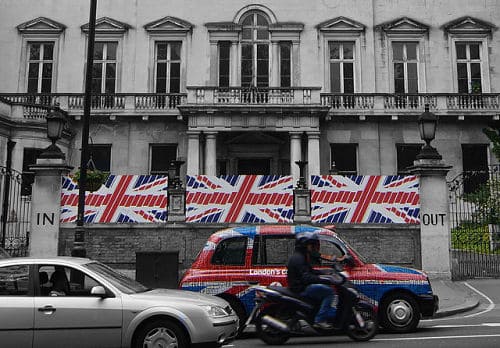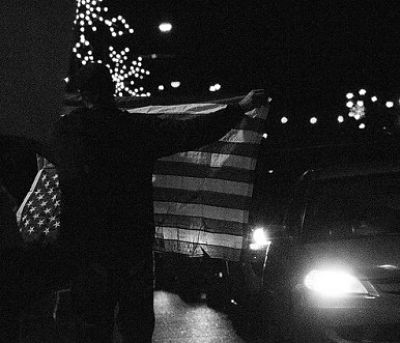In the days after the Brexit referendum, a friend in California confided that every morning he searched the internet for articles explaining why the Brexit outcome did not mean Donald Trump would win the U.S. presidential election. Only after this ritual, he said, could he begin his day, anxieties somewhat allayed.
In the U.S., Brexit has receded from public discourse, but the anxieties it aroused in my friend and many others, continue. These fears are related to Donald Trump’s presidential campaign, the country’s longstanding racial injustices, and an apparently restive white working class. There are disconcerting similarities between the Trump and Brexit phenomena. In both countries, as economic inequality intensifies and populations become more ethnically diverse (particularly in the U.S.), economic security is elusive for growing numbers of people—as are advantages that skin color or native birth once provided. In the U.S., recent police murders of black men, Black Lives Matter protests, and the killings of five Dallas police officers, reinforce fears that the U.S. is on the brink of its own electoral upheaval. The violent consequences of both the Brexit and Trump campaigns appear undeniable. In both the U.K. and U.S., racist rhetoric and violence are increasing.

Photo (cropped) by Duncan C (flickr, CC BY-NC 2.0)
In the wake of Brexit, our colleague Felix Stein called for anthropological engagement beyond the academy, specifically to address the xenophobic rhetoric associated with the Leave campaign. Felix’s post is a welcome call and rationale for public anthropology, and I wholeheartedly agree with him. However, the reception to his original piece, republished here on Allegra, along with my friend’s search for reassurance, has led me to reflect on the purpose of public anthropology. To whom do we wish to communicate, and to what end? As an anthropologist who has lived, worked, and conducted fieldwork in both the U.S. and the U.K. these questions are especially urgent.
To explain: Felix’s piece elicited some unexpected commentary on the APLA website, from readers who disagreed that the referendum result was about xenophobia. One commenter wrote, “The reality is that in England and Wales there are impoverished white communities who are constantly being told that their struggles are minimal compared to those of people of colour.” (Scroll to the end of Felix’s piece for comments.) This commenter echoes arguments made by public intellectuals, in which the political motivations of Brexit voters are explained in terms of either class or race. This commenter, like other analysts, connects the Brexit outcome and the precarity of working-class lives. Often, this insecurity is traced to neoliberal economic policies, and austerity in particular. This sort of “class-based” analysis suggests that a “freeing” of capital accompanied by freer movement of labor (ie, immigration) dispossesses working-class people; some versions of this argument, like the APLA commenter’s, suggest elites add insult to injury with “politically correct” condemnations of working-class discontent. A contrary strand of analysis interprets the politics of Brexit—and Donald Trump—as products of racial and ethnic animus, dangerously misdirecting political and economic grievances toward others.
As a political anthropologist, I find class vs. race arguments both unhelpful and empirically unsound.
Indeed, public assessments of the Brexit vote or the Trump campaign often reiterate the arguments of the campaigns themselves and, as such, may generate more heat than light. Perhaps the best contribution we can make as anthropologists is exploring how intersectional racial and class formations make Brexit or Trump appealing. Many of us have insights into why people in specific ethnographic contexts embrace certain politics.
Our research often explores synergies and intersections of race and class, and the use of ethnographic examples can compellingly illustrate how race and class are historically produced and reiterated in contemporary politics. Nevertheless, our public interventions must navigate a discursive context where race and class are often being treated as different, in some ways competing, forms of politics and analysis.
In terms of Brexit, John Harris’ and John Domokos’ Guardian series “Anywhere But Westminster” illustrates how working-class people see deindustrialization and flexible labor policies unsettling their lives, and links popular mistrust of expertise and media with this loss of security and certainty. In contrast, at Vox, Zack Beauchamp argues that votes to leave the EU were not rooted in rational economic reasons, but rather in xenophobia. These analyses are especially trenchant examples of a class or race analysis. Harris and Domokos are sympathetic to arguments that EU immigration harms native workers, while Beauchamp resists recognizing economic hardships.
Meanwhile, in the U.S., coverage of the rise of Donald Trump, his anti-immigration rhetoric, and his neo-confederate sympathizers poses a similar opposition between the economic insecurities of the white working class and racism or xenophobia. Thomas Frank, among others, argues that American workers’ lives have been destabilized by free trade and immigration, and Trump appeals to dissatisfaction with neoliberal economic policies. Others, like Sean McElwee and University of Maryland sociologist Philip Cohen, conclude that the primary motivation for Trump support is overt racism. Meanwhile, analysts like Nate Silver point out that Trump supporters actually enjoy higher incomes than average Americans, and thus do not indicate a groundswell of working-class support for Trump’s Mexican border wall or ban on Muslim immigration. (Future demographic analysis of Brexit voters may indeed complicate current assessments of Leave voters’ socioeconomic status, just as regional analysis has shown that a majority of voters in London, Scotland, and Northern Ireland voted to remain in the EU.)

Photo by Tyler Merbler (flickr, CC BY 2.0)
It would be somewhat solipsistic to propose that anthropologists are uniquely qualified to explore intersecting economic, racializing, and xenophobic features of Anglo-American political populism. There are many routes to clarity. In the U.S. example, scholars such as Angus Deaton and Anne Case highlight white working-class malaise quantitatively. Meanwhile, from a qualitative direction, journalists like Nikole Hannah-Jones, Ta-Nehisi Coates and Jamelle Bouie write compelling accounts and analysis of the broader intersections of race, class, and politics, and incorporate academic scholarship into their analyses.[i]
In fact, to engage in public discourse as professionals—as more than politically engaged citizens—we can learn a great deal from these journalists. In a recent post on black journalism, Ta-Nehisi Coates makes important points about authorship and audiences that are, like most true insights, transferrable to many other discursive situations. Coates argues that writing is shaped by specific contexts of experience and addressed to specific audiences. His broader approach to writing, in his blog, Twitter, and books, is especially useful for thinking about how to do public anthropology: we must be conscious of whom we address, acknowledge the subject positioning that produces our perspective, and in turn, like good ethnographers or conversationalists, allow our interlocutors’ responses to condition future utterances.
That is, public engagement requires listening as well as proclaiming, not just so we can better shape our messages to non-anthropologists, but also to shape and possibly transform the substance of what we study and teach.
That said, I have a few opinions about the intersections of race and class that Trump exploits the American context, and I do not see the rise of Trump only in terms of contemporary economics or demography; historical conditions cast a much longer shadow. In my current field site in Missouri, neither white poverty nor conflicts about race are new, although these conflicts have recently become more fraught. As most Allegra readers no doubt know, in August 2014, a black teenager named Michael Brown was killed by a police officer in Ferguson, Missouri. His killing, and a grand jury’s failure to indict his killer, underscored the structural and direct violence African American citizens face on a daily basis. As protesters mobilized in the aftermath of his death, Black Lives Matter grew from a Twitter hashtag, initially formed in response to the killing of Trayvon Martin in Florida, into a broad movement.

Photo (cropped) by Chris Wieland (flickr, CC BY-NC-ND 2.0)
Shortly after Brown’s death, African American students at a state university in Springfield, Missouri, the white majority city where I have been conducting fieldwork since 2013, organized a demonstration. At the event, thirty-odd young people silently carried “Black Lives Matter” signs past an outdoor party before a football game. Celebrators heckled students with racial expletives, threats, and calls to “Go back to St. Louis.”
Although the students were insulted by this abuse, many were sanguine, noting that the epithets hurled at them were part of their everyday lives. I recount this incident not because it is a particularly unusual or offensive sequence of events, but because it is in fact depressingly commonplace these days. The Black Lives Matter movement speaks to past and present violence, dispossessions and exclusions faced by African Americans. But what of the white “tailgaters” who shouted racist abuse at the students?
People attending university sports events are not poster children for white poverty. Although it is true that middle-class people in the U.S. are increasingly feeling insecure, especially about their childrens’ futures, the hostility on display that night was not directed at people challenging their economic position.
That these white citizens were comfortable shouting racist abuse at protesters speaks more to the enduring legacies of Missouri’s history than to economic anxieties—or a Trump candidacy that had yet to materialize.
Missouri was a slaveholding state, and in the twentieth century, as African Americans migrated to industrial jobs, they were met by violent white backlashes in cities across the state.[ii] The contemporary politics and demography of Missouri, and the city of St. Louis, are bound up with past patterns of migration, violence, and expulsion. Foreshadowing the East St. Louis pogrom of 1917 and the Red Summer of 1919, in the early twentieth century, waves of mass violence against African Americans rolled across the state. These past atrocities, and political economic struggles, resonate throughout present-day politics.
Black Lives Matter continues longer historical debates among African Americans about respectability politics, representation, and nonviolence. For the white backlash, there are less illustrious historical antecedents, from the Confederate States of America to White Citizens’ Councils. This backlash, whether to African American workforce competition and growing political power in the 1910s, or to black activism today, is not simply misdirected class politics; American experiences of class remain inseparable from racial inequality, chattel slavery, and ultimately, white supremacy.
In the present day, what we see is a synergy of class and race, with a large amount of what Robin DiAngelo (2011) calls “white fragility:” “a state in which even a minimum amount of racial stress becomes intolerable, triggering a range of defensive moves.” (57).
Yet who in the “public” is really interested in receiving this point, and the larger ethnographic and historical analysis it is drawn from? All too often, the audience for such discussion is like-minded academics, while its subjects, when they notice the discussion, interpret it as dismissing or discrediting the authenticity of their experiences and politics.
Public anthropology may have been easier in the past. In the early to mid-nineteenth century, Franz Boas, Ruth Benedict, Ashley Montagu and others effectively intervened in public debates about race. Their work was given urgency by both the rise of fascism and U.S. xenophobia. The greater security of academic employment at the time may have also facilitated these efforts, giving scholarly communication within the discipline less personally perilous stakes, and freeing scholars to address broader audiences. Yet we would do well to reflect upon how our efforts to position our scholarship within a competitive job market create analyses addressed more to our academic colleagues than broader audiences. What we hear when we engage in political debates should rightly influence not just what we say beyond anthropology, but what we say among ourselves.
In a recent post on W.E.B. Du Bois’ Black Reconstruction in America, Ta-Nehisi Coates writes that, “He wrote knowing full well that what he said was neither palatable nor negotiable, that a large portion of the country would not be swayed, and that the truth, in and of itself, must be enough.” Although I am conscious of readers like my Californian friend and the APLA commenter, I am not certain that anthropological research can or even should address their concerns. Purposefully addressing diverse audiences, listening to their responses, public engagement itself—these actions are not just about bringing comfort or legitimizing our work.
Instead, finding ways to communicate with multiple audiences is an ethical orientation, and political imperative, across our professional activities – if only so we can live with ourselves and others.
[i] Their writing also introduces new audiences to research of significant public importance, such as Ira Katznelson’s When Affirmative Action Was White, Nell Painter’s The History of White People, and David Roediger’s Wages of Whiteness.
[ii] For history of the migration of African Americans from the south to industrial jobs in this period, see Isabel Wilkerson, The Warmth of Other Suns: The Epic Story of America’s Great Migration. For histories of Red Summer, see Cameron McWhirter, Red Summer: The Summer of 1919 and the Awakening of Black America and Jan Voogd, Race Riots and Resistance: The Red Summer of 1919. For history of the 1917 East St. Louis pogrom, see Charles Lumpkins, American Pogrom: The East St. Louis Race Riot and Black Politics. For history of the earlier wave of post-Reconstruction violence in Missouri, see Kimberly Harper, White Man’s Heaven: The Lynching and Expulsion of Blacks in the Southern Ozarks, 1894-1909.
Featured image by Wissotzky (flickr, CC BY-ND-NC 2.0)










There is a deep seated anti-intellectualism in the UK, fuelled by foreign owned media outlets, politicians and even much of the BBC. It is no wonder that ‘expert’ views of the dangers of Brexit were so easily dismissed as scaremongering, a rebuttal against which there was no logical comeback. Dismissing intellectual debate and training is an essential and invariable trait of authoritarian regimes everywhere.